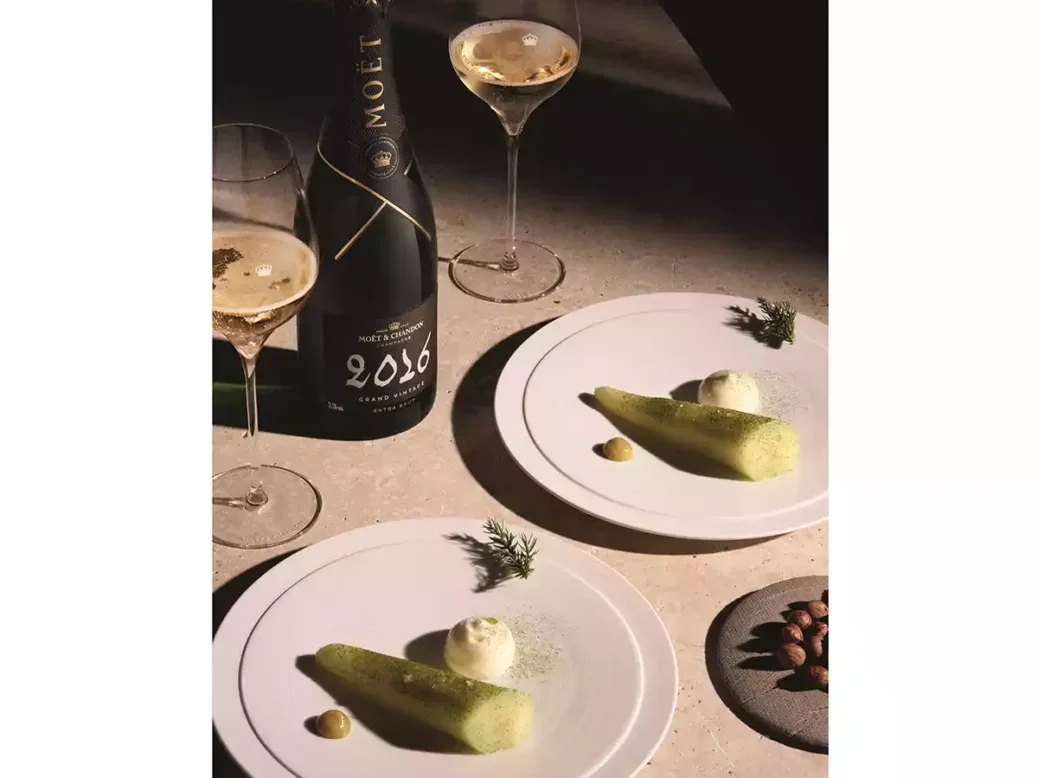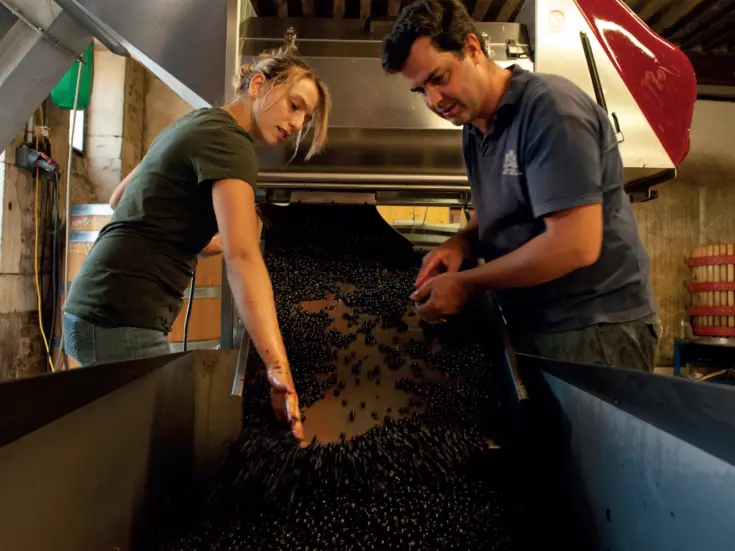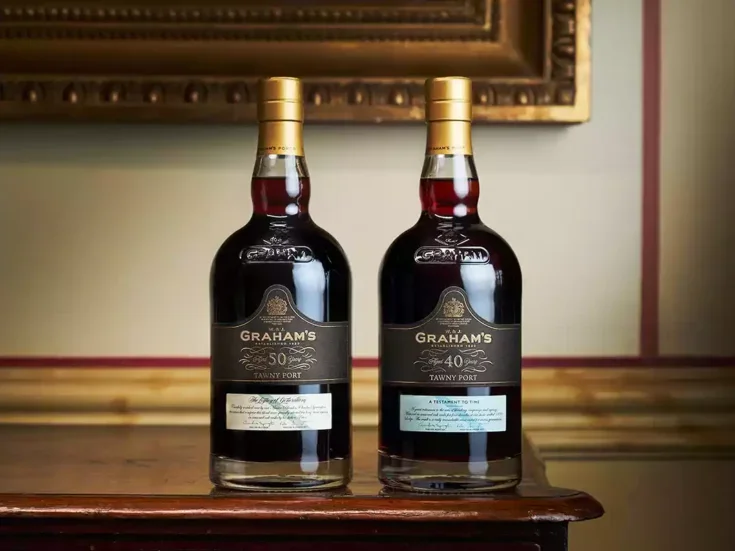
Anne Krebiehl MW tastes the latest Moët & Chandon Grand Vintage alongside two new late-disgorged Grand Vintage Collection wines from similarly “turbulent” years.
As is the way with Vintage releases at Moët & Chandon, they now come in threes: the most recent Grand Vintage releases—this year from 2016 in both white and rosé—plus two late-disgorged vintages, namely the Grand Vintage Collection 2009 and 2000. These are the same blends as the originally released vintages but sealed under cork and aged for much longer, both of them chosen for certain parallels to the 2016 vintage.
While the marketing materials refer to this trio of 2000, 2009, and 2016 as “three turbulent years” that tell a “tale of sublimation,” Moët cellar master Benoît Gouez translated this into real information. He called the 2016 vintage in Champagne “a return to a year of classic vicissitudes” after the “extreme drought” of 2015, then duly enumerated these vicissitudes. “It started with quite a warm winter, followed by a very rainy spring, with some frost, especially in the Aube, where almost 50% of the crop was destroyed. Then, a little like this year, there was a lot of pressure from mildew. We think we globally lost about 15% of the yield. In the summer, the sun came back with some drought events; we even had some sunburn on the grapes and some coulure [failure of fruit development], so we lost even more grapes.” Quite a year of challenges, then, but with some light at the end of the tunnel: “The weather was good enough, and the harvest was clean,” Gouez said, emphasizing, “No rot is almost the first element of quality, and surprisingly the harvest was very clean, with moderate alcohols and only some heterogeneity. Everything was harvested between 9.5% and 10% [potential alcohol] across Chardonnay, Pinot Noir, and Meunier.” Harvest started on September 17, which, for the modern era, was quite a late harvest, starting with Meunier. Gouez said, “Unusually, the Chardonnay was harvested after the Pinot Noir and the Meunier.”
Gouez also dwelled on the figure of 9.5% potential alcohol, which he believes is “always the minimum to produce a great vintage. If you take the 30 vintages that have been rated highest [aggregated critical scores], it turns out that 24 of them were harvested with at least 9.5%.” He also noted the “good acidity of 7–7.5g/l in the musts” (expressed as sulfuric acid, which translates into 10.5–11.25g/l when expressed as tartaric). “Compared to what we have nowadays, it was quite good,” he said, adding that the rain in spring had provided the grapes with sufficient nitrogen for the musts to ferment without any problems.
Gouez also noted that, in 2016, “the decision was made to use more Chardonnay,” resulting in a final blend of 48% Chardonnay, 34% Pinot Noir, and 18% Meunier. “Why?” he asked rhetorically; “Because the Chardonnay was rather vibrant and citrusy. Making a blend for a Vintage is for me really about being seduced. And sometimes you are seduced by something and you do not even know why. So, perhaps because the Chardonnays were harvested after the Pinot Noir and the Meunier? Who knows?”
Gouez said that while the 2016 growing season was “challenging for the growers, the harvest, fermentations, and blending were easy. What I like in 2016 is that idea that even under challenging circumstances, there is a sense of the resilience of Champagne.” His honesty is to be commended, including his overall vintage assessment of 2016: “A good Champagne harvest, with wines described as nice, balanced, easy to drink. I think the wines are peaceful and serene, considering all the climatic circumstances we had.” The wines bear this out, the white wine expressing a scented, fruity smoothness, with relatively marked autolytic flavors. Gouez said that “there is a question of room in the wine. I always believe that the less fruity the wine, the more room for autolysis. And when I say 2016 is not a fruit-bomb, the fruitiness is again serene and delicate.” The wine is absolutely ready to drink now, with the rosé coming out on top. It is a rather seductive, scented rosé that proves itself—just like its Non-Vintage sibling, the Brut Impérial Rosé—to be a supremely versatile wine at the table, and for me the winner of the year, also absolutely ready to drink now but likely to evolve beautifully, becoming ever more gastronomic. Gouez also noted that both 2016 Vintage wines—as always since 2002—received a dosage of just 5g/l when they were disgorged in January 2024.
Tasting
Moët & Chandon Grand Vintage 2016
A rich, juicy nose, showing yellow apple, apple blossom, golden mirabelle, and springy, freshly baked sponge cake, with a sprinkling of salt. These fruits continue onto the palate, where they are immediately embraced by freshness, backed by rich, sponge-cake-like flavors bound up with chalkiness. As the wine lingers in the mouth, slight citrus pith and pervasive freshness become apparent. A gentle wine, running along a central line of bright, smooth freshness and a promising, haunting hint of umami. | 92
Moët & Chandon Grand Vintage 2016 Rosé
“This time, there is a bigger Pinot influence,” Gouez said. It is a blend of 43% Pinot Noir—a proportion resulting from 30% white base wine and 13% of red wine from Aÿ, Mareuil, and Bouzy—42% Chardonnay, and 15% Meunier.
The nose of the copper-hued wine is vividly aromatic and recalls umeshu plum, with vivid red grapefruit and mulberry immediately apparent on the first sniff, while more air brings tisane of hibiscus and rosehip. The palate has a slight overtone of white truffle and smokiness, plunging into its wonderfully tart heart of red grapefruit and juicy plum, still with overtones of rosehip tisane. All this is backed by a gentle, buttery saltiness, tapering to fine freshness. | 93
Moët & Chandon Grand Vintage Collection 2009
This late-disgorged Vintage was aged for 14 years under cork and agrafe and is a blend of 50% Pinot Noir, 36% Chardonnay, and 14% Meunier. It was disgorged in June 2023, with a dosage of 5g/l.
Evolution is evident on the nose, with caramel biscuit, cooled wax, lemon juice, and apricot skin projecting richness. More air brings in an ethereal, dried lemon-peel lift that verges into more waxiness. The palate continues in this rich vein, presenting generosity, with the aromatic richness of baked apricot and quite a firm phenolic frame that is inextricable from that biscuity, wheat-bran vibe and the lemony pith. Much concentration, much flavor, much freshness, and pleasant bitterness on the long, spicy finish. | 94
Moët & Chandon Grand Vintage Collection 2000
This late-disgorged Vintage was aged for 14 years under cork and agrafe and is a blend of 50% Chardonnay, 34% Pinot Noir, and 16% Meunier. It was disgorged in 2015, with a dosage of 7g/l.
Golden in color, it opens with notes of wet chalk, dried shiitake, dried corn husk, and lemon. They come together with a slight highlight of honey. The palate has a vivid saltiness that initially accentuates those flavors of dried corn husk before becoming more and more akin to oyster shell. Evolution is evident in notions of white truffle, white field mushroom, and hay, again with a veil of phenolics, losing a little focus on the finish. | 93







